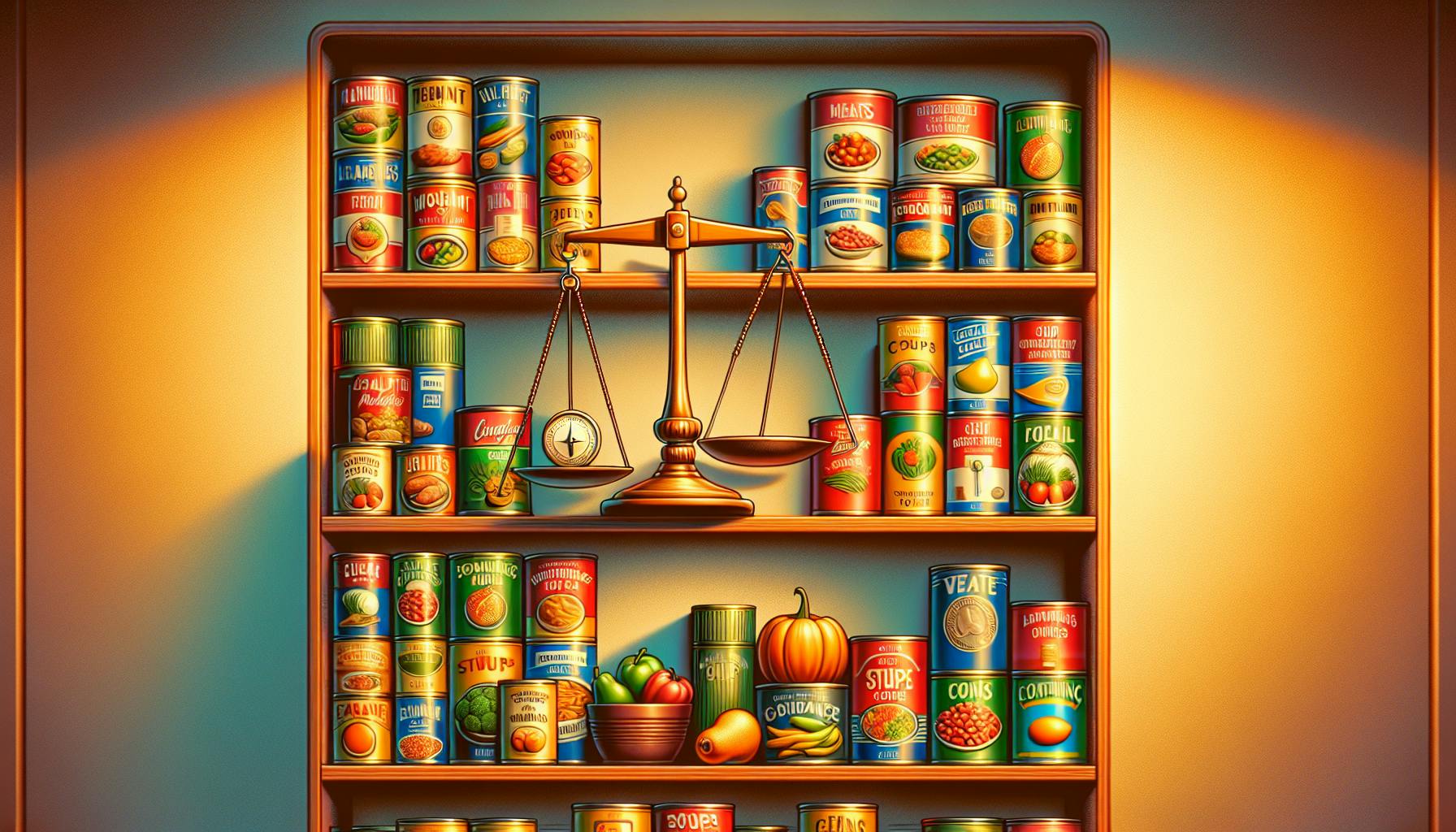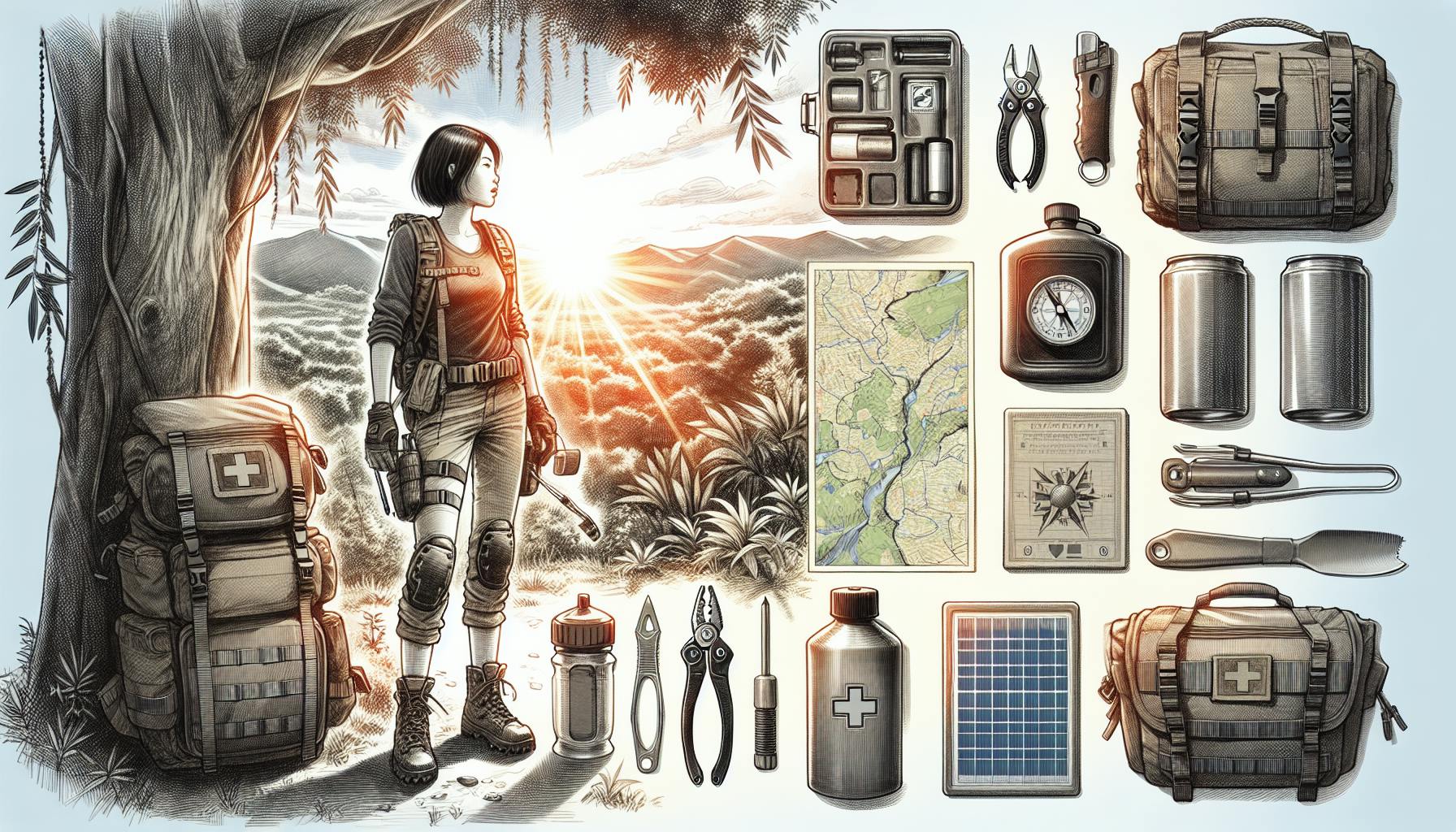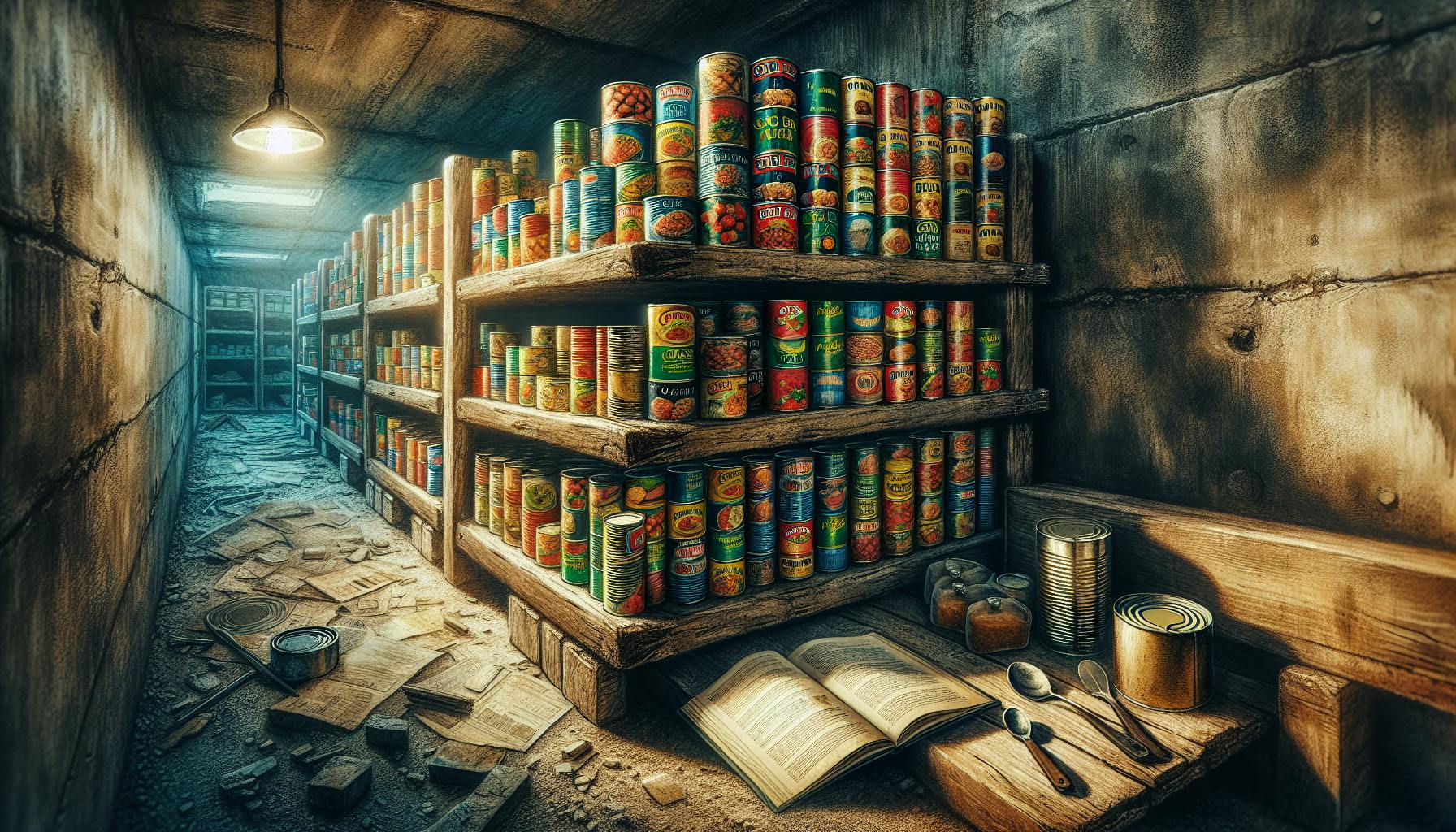When building an emergency food stockpile, most preppers would agree that canned goods are an essential component for survival preparedness.
By selecting the most nutrient-dense canned foods and combining them with other survival food sources, you can create a well-rounded stockpile that will sustain you through any disaster scenario.
In this guide, you'll discover the best canned foods to stockpile for survival based on nutrient density, shelf life, variety, and food safety.
Introduction to Nutrient-Rich Canned Foods for Survival
Canned foods can play an important role in an emergency food stockpile. When fresh produce is unavailable, having nutrient-rich canned options on hand provides essential vitamins and minerals. As you prepare your emergency preparedness kit, focus on canned varieties that are low-sodium and packed with key nutrients.
Understanding the Role of Canned Foods in Emergency Preparedness
Canned foods are an integral part of any emergency stockpile because they provide nutrients and don't require refrigeration. The canning process allows food to be shelf-stable for 1-2 years or longer, ensuring you have backup meals if the power goes out. Canned fruits and vegetables retain many of the vitamins and minerals found in their fresh counterparts. Just be sure to look for low-sodium or "no salt added" varieties whenever possible.
To keep your body functioning properly during a crisis, you'll need adequate nutrition from macronutrients like protein, carbs and fat as well as essential vitamins and minerals. Relying solely on freeze-dried meals or snacks like granola bars could lead to malnutrition over time. Adding nutrient-rich canned foods helps round out your diet.
Selecting the Best Canned Foods for Your Survival Stockpile
When selecting canned goods for emergencies, look for fruits packed in juice rather than heavy syrup, which has added sugar. Seek out vegetables with lower sodium levels or aim for "no salt added" varieties.
Prioritize canned beans, salmon, tuna, fruits and tomatoes on your stockpile checklist. Beans offer protein, fiber and iron while canned fish provides omega-3 fatty acids and protein. Canned tomatoes can be used in soups, stews and sauces for a nutrition boost.
You'll also want to include a variety of canned vegetables like carrots, spinach, mixed veggies and low-sodium soup. Round out your stockpile with high-protein canned meats like chicken or turkey.
Creating a Food Stockpile Checklist
A well-rounded emergency food stockpile should include a variety of canned goods that don't require refrigeration. Here's a checklist of non-perishable foods to have on hand:
- Canned tuna, salmon, chicken, turkey
- Canned beans, vegetables, tomatoes
- Canned fruits packed in juice
- Canned low-sodium soups and vegetables
- Canned meats like spam or turkey sausage
- Granola bars, protein bars
- Powdered milk, cereal, oats
When creating your stockpile, be sure to calculate how much food you need for the number of people in your household and the expected length of an emergency situation. Check expiration dates and aim to use and replace items before they expire.
The Importance of Variety in Your Survival Diet
Eating the same canned foods day after day could cause flavor fatigue and nutritional deficits. Having variety helps make meals more appetizing while also providing a mix of nutrients to nourish your body during a crisis.
Include canned fish, meats, beans, fruits, vegetables, soups and broths. If you have the space, also stock freeze-dried vegetables, canned pasta, rice, spices, honey and shelf-stable snacks.
Eat canned fish like salmon a couple times a week for omega-3s. Have canned soup as a starter or snack. Add canned vegetables to rice, pasta or quinoa for stir fries. Mix up flavors and textures to keep your palate happy.
Ensuring Food Safety and Quality
Check expiration dates on canned goods before adding them to your stockpile. While cans have a long shelf life, the quality can degrade over several years.
Write the purchase date on cans with a marker to make rotation easier. Plan to use and replace items from your stockpile before they expire. This helps ensure you have fresh emergency reserves.
During a power outage, keep canned goods in a cool, dry place to prevent spoilage. Never eat from cans that are leaking, bulging or severely dented along the seams, as bacteria could have contaminated the contents.
By stocking up on a variety of nutrient-rich canned foods, you'll be prepared with emergency meals that don't require cooking or refrigeration when fresh foods are inaccessible. Just be diligent about checking expiration dates and proper storage.
What 2 foods can you survive on?
A balanced diet of survival food is critical to ensure your body gets the nutrients it needs. If limited to just two foods, here are some good options:
Potatoes and Beans
Potatoes are packed with complex carbohydrates, fiber, vitamins C and B6, and minerals. Beans also provide fiber, protein, iron, zinc, and B vitamins.
Together, potatoes and beans create a combo that delivers protein, carbs, fiber, and essential vitamins and minerals. They make a tasty and nutritious survival food duo.
Some easy recipes with potatoes and beans:
- Baked potatoes stuffed with chili or refried beans
- Potato and bean soup
- Roasted potatoes and beans
Canned or dried potatoes and beans have a long shelf life, making them ideal for stockpiling. Opt for low-sodium versions when possible.
Stay hydrated and supplement with other foods when available for a more balanced diet. But this duo can sustain you through challenging times when options are limited.
What is the best long life canned food?
When building your food stockpile for emergency preparedness, focusing on canned goods with longer shelf lives is key to ensuring you have nutritious food available when needed. According to food safety experts, the longest-lasting canned foods are:
- Canned meat (spam, chicken, beef, etc.) - lasts 4-30 years. Provides protein.
- Canned vegetables (carrots, peas, corn, etc.) - last 3-8 years. Good source of vitamins and minerals. Low-sodium options available.
- Canned beans - last 3-6 years. Excellent source of plant-based protein, fiber, and nutrients.
- Canned fish (tuna, salmon, sardines, etc.) - last 3-6 years. Omega-3 fatty acids.
- Canned rice/pasta - lasts 2-6 years. Provides carbohydrates.
- Canned broth - lasts 3-5 years. Adds flavor and nutrients to dishes.
- Canned soups - last 2-4 years. Convenient meal starter.
- Canned fruits - last 1-2 years. Provides fiber, vitamins.
When stockpiling canned goods, be sure to:
- Check expiration dates and use first-in, first-out system
- Store in cool, dark place to maximize shelf life
- Include variety for balanced nutrition
- Have can opener and cooking backup plan
Prioritizing longer-lasting canned foods allows you to build reserves of nutritious food for emergency preparedness.
What is the best food to stock up on for survival?
When building an emergency food supply, commercially canned foods are one of the best options to consider. Canned foods are shelf-stable and do not require refrigeration until opened, making them ideal for stockpiling. They are also already cooked, so you can eat them straight from the can if needed.
Some of the best canned foods to stock up on for survival include:
- Canned vegetables like carrots, green beans, corn, and potatoes. Opt for low-sodium varieties when possible. Canned veggies provide essential nutrients and can be eaten on their own or incorporated into meals.
- Canned fruits like pineapple, peaches, pears, and apple sauce. The fruit is already prepped so you can eat it right away. Canned fruit offers an easy way to get vitamins from fruit when fresh isn't available.
- Canned proteins like tuna, salmon, chicken, and beans. Tuna and other canned fish offer protein, healthy fats, calcium, and other nutrients. Beans also provide protein, fiber, and nutrients.
- Canned soups and stews, like vegetable, minestrone, chili, and beef stew. The cans contain already prepared meals, so you just need to heat and eat. Soups provide hydration along with calories and nutrients.
When building your stockpile, focus on nutrient-dense foods over sugary or salty options. Check expiration dates and store cans in a cool, dry place. Make sure to have a can opener on hand. Rotate out cans as you use them to keep foods fresh. With some planning, canned foods can provide you with essential nutrients during an emergency.
sbb-itb-b932644
Should I stockpile canned food?
Canned goods can be an excellent addition to an emergency food stockpile. Here are some key reasons to consider stockpiling canned foods:
-
Long shelf life: Properly stored canned goods can last for years without refrigeration. Just be sure to check expiration dates and watch for dents or damage.
-
Nutrient density: Many canned options like vegetables, beans, and fish are rich sources of protein, fiber, vitamins, and minerals. Choose low-sodium versions when possible.
-
Convenience: Canned goods are ready to eat after opening, requiring no cooking or preparation. This makes them handy during a disaster when utilities may be impacted.
-
Affordability: Buying shelf-stable canned goods in bulk is often cheaper per serving compared to fresh options. Stock up when items go on sale.
When building your stockpile, focus on nutrient-rich canned foods like vegetables, fruits packed in juice, beans, tuna, and salmon. Avoid sugary or heavily processed options. Rotate items to use oldest first and replace anything past expiration. With some planning, canned goods are a smart, budget-friendly disaster preparedness essential.
Building Your Emergency Canned Food Supply
Building an emergency food supply with canned goods can provide you with reliable, nutrient-rich options that last a long time without refrigeration. When stocking up on canned foods for disasters or other emergencies, focus on variety, nutritional value, and shelf life.
Best Food to Stockpile for Apocalypse
For extreme disaster preparedness scenarios, prioritize canned goods that are calorie-dense and packed with essential vitamins and minerals. Top picks include:
- Canned beans - High in fiber, protein, and complex carbs
- Canned salmon or tuna - Excellent sources of omega-3s and protein
- Canned vegetables like carrots, spinach, and tomatoes - Packed with vitamins and minerals
- Canned fruits in juice or water - Provide vitamin C and antioxidants
- Canned soups and stews - Offer calories, protein, veggies, and convenience
Choose low-sodium versions whenever possible for nutritional value and health.
Low-Sodium Options for Healthier Choices
To limit sodium intake from canned goods during emergencies, opt for "no-salt-added" or "low sodium" on the label. Good options include:
- Canned beans, vegetables, soups and tomatoes
- Canned salmon, tuna, chicken
- Canned fruits packed in juice or water rather than syrup
Pair with unsalted nuts, crackers or rice cakes for extra nutrients and variety.
Canned Foods You Don't Have to Refrigerate
Since power outages can occur during disasters, focus your canned food stockpile on shelf-stable items that do not require refrigeration before or after opening:
- Canned meats like tuna, salmon, chicken
- Canned beans, soups, vegetables
- Canned fruits packed in water or juice
- High-acid foods like tomatoes, pineapple
Avoid canned cream-based soups, pasta, milk, and other perishable items.
Longevity of Canned Goods: What to Know
Properly stored canned foods can last 2-5 years on average, with some lasting even longer. To maximize shelf life:
- Store in cool, dry place below 85°F
- Avoid direct sunlight, temperature fluctuations
- Check for dents, damage, swelling, corrosion
- Note expiration or "best by" dates
Use FIFO method: first in, first out. Rotate stock every 6-12 months.
Storing and Rotating Your Canned Food Stock
Organize cans so you can easily see and access items. Group like items together. Label containers or shelves with contents and dates.
Aim to use and replace 1-2 cans per week to maintain a fresh stock. Mark purchase dates on cans with markers. Use oldest cans first following the FIFO system.
Proper storage and rotation helps maximize shelf life so you can rely on nutrient-rich canned goods when you need them.
Maximizing Nutrition with Canned Foods
Canned foods can form the backbone of a nutritious emergency food supply. However, relying solely on canned goods limits variety and certain micronutrients. Combining canned items with other shelf-stable foods ensures a more balanced diet. Supplements also help fill nutritional gaps.
Combining Canned Foods with Other Nutrient Sources
- Pair canned vegetables, soups, and beans with brown rice, whole wheat pasta, oats, and quinoa for balanced meals. Complex carbs provide fiber, protein, and nutrients canned goods may lack.
- Nuts, peanut butter, and dried fruits add healthy fats, protein and micronutrients like vitamin E, magnesium, and potassium. Trail mixes make nutritious, easy snacks.
- Canned tuna, salmon, chicken, and other meats offer protein to complement fruits, veggies, beans and carbs.
- Powdered milk, evaporated milk, and shelf-stable soymilk provide calcium, vitamin D and protein to round out canned ingredients.
The Role of Supplements in a Canned Food Diet
- A daily multivitamin helps fill nutritional gaps like vitamin C, calcium, iron and vitamin D that canned goods lack.
- Vitamin C, vitamin D3, calcium, and iron supplements prevent deficiency of nutrients scarce in canned items.
- Consider probiotic capsules to support healthy gut flora since canned goods lack beneficial bacteria.
- Talk to your doctor before taking any new supplements, especially with existing medical conditions.
Diversifying Your Diet with Freeze-Dried and Dehydrated Foods
- Freeze-dried fruits, vegetables, meats and meals provide lightweight variety.
- Dehydrated produce like apples, bananas, sweet potatoes add fiber and nutrients.
- Powdered eggs, milk and butter provide essential protein and fat without refrigeration.
- Companies like Mountain House and Thrive specialize in freeze-dried and dehydrated survival foods.
Integrating Fresh Foods When Available
- Incorporate fresh produce and meats from the grocery store to diversify your supply.
- Grow sprouts and microgreens indoors from seeds as mini-gardens with vitamins.
- Forage for wild berries, mushrooms and edible plants if circumstances permit.
- Learn skills like canning, pickling and curing to preserve seasonal abundance.
The Importance of Hydration
- Drink at least 64 oz. of water daily, more if physically active. Dehydration causes fatigue and illness.
- Water filters like Sawyer remove bacteria and viruses from found water sources.
- Add powdered drink mixes to water for micronutrients and to improve taste.
- Stock metal water containers and have a rain catchment plan as backup sources.
Safe Consumption of Canned Foods in Emergencies
When relying on canned goods during an emergency, it's important to handle and prepare them properly to prevent foodborne illness. Here are some best practices:
Preventive Measures to Avoid Contamination
- Wash hands thoroughly with soap and water before and after handling canned items
- Sanitize countertops, can openers, utensils, and other surfaces
- Carefully inspect cans for damage before opening - discard any dented, cracked, or swollen cans
- Clean can lids before opening to prevent debris from contaminating the contents
- Use a manual can opener, not an electric one, to reduce risk of sparks/fire
Spotting Signs of Canned Food Spoilage
- Check that the can is still sealed and not leaking or bulging
- Verify the contents look and smell as expected - discard if moldy, discolored, or foul-smelling
- Do not taste food from damaged or potentially compromised cans
Disposing of Compromised Canned Goods
- Place spoiled canned goods in secure plastic bags
- Double bag to prevent leaks before putting in covered trash receptacles
- Remove trash frequently to avoid vermin being attracted to smells
Reducing Sodium Intake from Canned Foods
- Choose low-sodium canned options whenever possible
- Rinse salted canned items like beans, vegetables, or tuna before use
- Balance meals with fresh items or unsalted canned foods
Maintaining Adequate Fluid Intake
- Drink sufficient water - canned foods are often high in sodium
- Target around 2-3 liters of fluids daily depending on size/activity level
- Include hydrating foods like fruits or broths when possible
Staying vigilant with safe food handling practices, inspection, and preparation allows you to utilize your canned good reserves while minimizing risks of foodborne illnesses during emergencies.
Conclusion: Preparing for Uncertainty with the Best Canned Foods
Canned foods can play an integral role in emergency preparedness by providing a reliable source of essential nutrients when fresh options are unavailable. As summarized in this article, the best canned foods for survival stockpiles are ones that offer a balance of protein, vitamins, minerals, and complex carbohydrates.
When building your food supply, focus on nutrient-dense options like canned beans, vegetables, fruits packed in juice, tuna, salmon, and low-sodium soups or stews. Aim for variety to meet all your nutritional needs. Track expiration dates closely and follow the FIFO system to rotate stock.
Properly storing canned goods is also key - keep them in a cool, dry area and inspect regularly for damage or swelling. Consider adding supplemental items like multivitamins, electrolyte mixes, and high-calorie proteins bars.
Adopting basic food safety habits will ensure you safely preserve perishables during a power outage. Limit opening the refrigerator, keep ice on hand, and monitor internal temps. Cook, reheat, and consume thawed items promptly.
Preparing for uncertainty means having reliable access to healthy sustenance. Stock up on nutrient-rich canned goods, store them properly, and integrate them into a balanced diet over time to optimize your readiness. With some planning, canned foods can provide the fuel you need to withstand an emergency.


